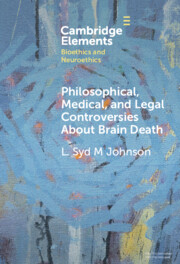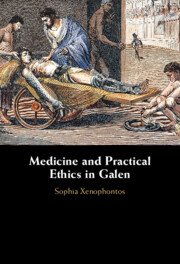253 results
Chapter 2 - “Strewn promiscuously about”
-
- Book:
- Disability, the Body, and Radical Intellectuals in the Literature of the Civil War and Reconstruction
- Print publication:
- 04 July 2024, pp 71-102
-
- Chapter
- Export citation
14 - Sexuality in Islamic Traditions
-
-
- Book:
- The Cambridge World History of Sexualities
- Published online:
- 26 April 2024
- Print publication:
- 16 May 2024, pp 293-313
-
- Chapter
- Export citation
2 - The Black Body and the Medical Archive
- from Part I - Extraction and Abstraction
-
-
- Book:
- The Cambridge Companion to the Black Body in American Literature
- Published online:
- 09 May 2024
- Print publication:
- 16 May 2024, pp 32-48
-
- Chapter
- Export citation
Chapter 3 - Health and Sickness
- from Part I - Personal
-
-
- Book:
- Jonathan Swift in Context
- Published online:
- 02 May 2024
- Print publication:
- 09 May 2024, pp 18-25
-
- Chapter
- Export citation
Therapeutic Practices and Healing Cultures in Accra - Sharing the Burden of Sickness: A History of Healing and Medicine in Accra Jonathan Roberts. Bloomington: Indiana University Press, 2021. Pp. 420. $85.00, hardcover (ISBN: 9780253057945); $36.00, paperback (ISBN: 9780253057938); $35.99, ebook (ISBN: 9780253057921).
-
- Journal:
- The Journal of African History , First View
- Published online by Cambridge University Press:
- 08 May 2024, pp. 1-3
-
- Article
- Export citation
World Organization of National Colleges, Academies and Academic Associations of General Practitioners and Family Physicians (WONCA) Europe position paper on the use of point-of-care ultrasound (POCUS) in primary care
-
- Journal:
- Primary Health Care Research & Development / Volume 25 / 2024
- Published online by Cambridge University Press:
- 23 April 2024, e21
-
- Article
-
- You have access
- Open access
- HTML
- Export citation
How Did Nineteenth-Century Singers Care for Their Voice?
-
- Journal:
- Royal Musical Association Research Chronicle ,
- Published online by Cambridge University Press:
- 02 April 2024, pp. 1-29
-
- Article
-
- You have access
- Open access
- HTML
- Export citation
The Clinical Gaze of Lurianic Kabbalah
-
- Journal:
- Harvard Theological Review / Volume 117 / Issue 2 / April 2024
- Published online by Cambridge University Press:
- 15 May 2024, pp. 268-292
- Print publication:
- April 2024
-
- Article
- Export citation
4 - Dissecting Matter
-
- Book:
- Before the Word Was Queer
- Published online:
- 14 March 2024
- Print publication:
- 21 March 2024, pp 117-144
-
- Chapter
- Export citation
15 - Health
- from Part II - Essential Signs
-
- Book:
- Chinese Signs
- Published online:
- 29 February 2024
- Print publication:
- 07 March 2024, pp 138-146
-
- Chapter
- Export citation

Philosophical, Medical, and Legal Controversies About Brain Death
-
- Published online:
- 22 February 2024
- Print publication:
- 21 March 2024
-
- Element
- Export citation
6 - Resilience
-
- Book:
- A Concise History of the Aztecs
- Published online:
- 08 February 2024
- Print publication:
- 15 February 2024, pp 202-245
-
- Chapter
- Export citation
Chapter 16 - Forgotten Class
- from Part III - Applications: Politics
-
-
- Book:
- Literature and Medicine
- Published online:
- 17 January 2024
- Print publication:
- 18 January 2024, pp 281-296
-
- Chapter
- Export citation
Ethical Shortcomings of QALY: Discrimination Against Minorities in Public Health
-
- Journal:
- Cambridge Quarterly of Healthcare Ethics , First View
- Published online by Cambridge University Press:
- 15 January 2024, pp. 1-8
-
- Article
- Export citation
Introduction
-
- Book:
- Medicine and Practical Ethics in Galen
- Published online:
- 14 December 2023
- Print publication:
- 04 January 2024, pp 1-18
-
- Chapter
-
- You have access
- Open access
- HTML
- Export citation
Chapter 5 - Exhortation to the Study of Medicine
- from Part II - Case Studies
-
- Book:
- Medicine and Practical Ethics in Galen
- Published online:
- 14 December 2023
- Print publication:
- 04 January 2024, pp 95-123
-
- Chapter
-
- You have access
- Open access
- HTML
- Export citation
28 - The American Essay and (Social) Science
- from Part III - Postwar Essays and Essayism (1945–2000)
-
-
- Book:
- The Cambridge History of the American Essay
- Published online:
- 28 March 2024
- Print publication:
- 14 December 2023, pp 477-489
-
- Chapter
- Export citation

Medicine and Practical Ethics in Galen
-
- Published online:
- 14 December 2023
- Print publication:
- 04 January 2024
-
- Book
-
- You have access
- Open access
- Export citation
ERICHTHO THE DOCTOR? MEDICAL OBSERVATIONS ON LUCAN'S NECROMANTIC EPISODE
-
- Journal:
- The Classical Quarterly / Volume 73 / Issue 2 / December 2023
- Published online by Cambridge University Press:
- 26 February 2024, pp. 777-785
- Print publication:
- December 2023
-
- Article
-
- You have access
- Open access
- HTML
- Export citation
14 - The Medical Revolution in Early Modern Japan
- from Part III - Social Practices and Cultures of Early Modern Japan
-
-
- Book:
- The New Cambridge History of Japan
- Published online:
- 15 January 2024
- Print publication:
- 23 November 2023, pp 478-506
-
- Chapter
- Export citation



